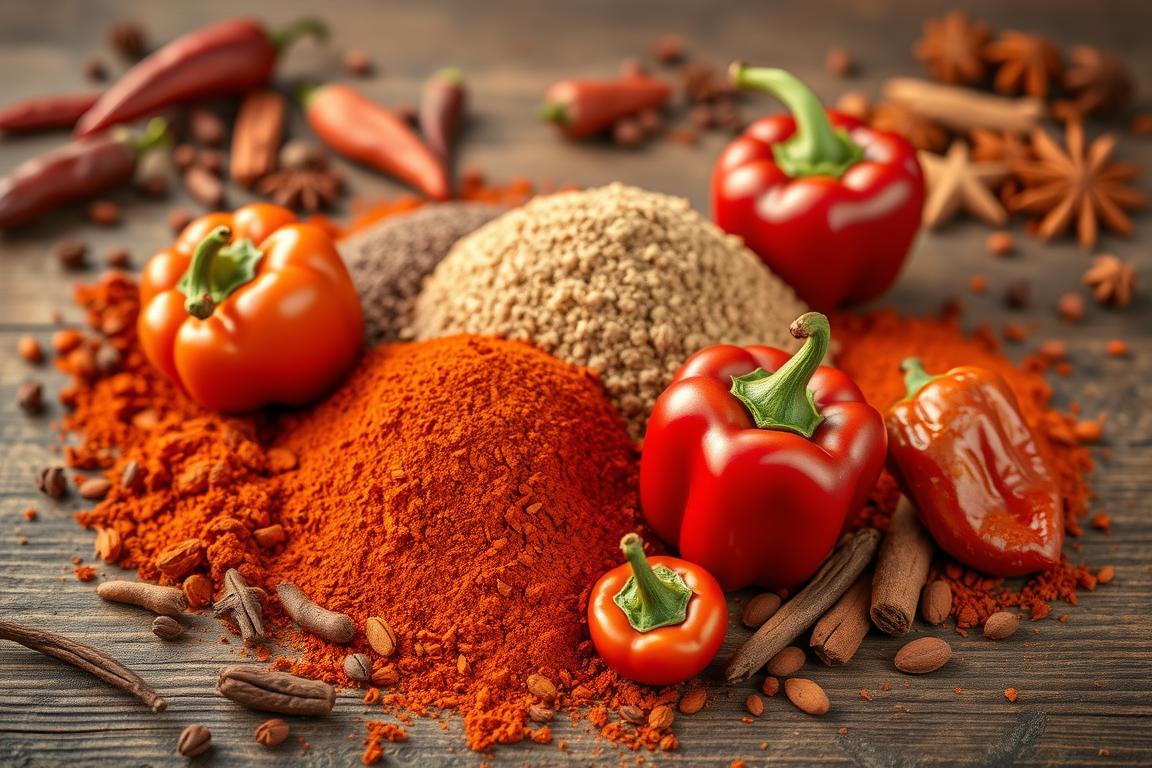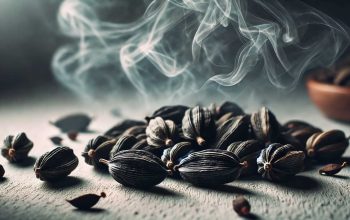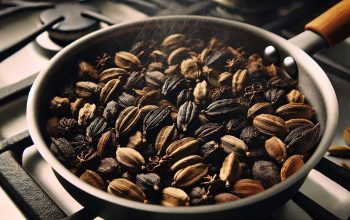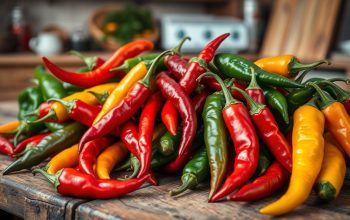Smoked paprika is a spice made from dried and ground capsicums. It adds a smoky flavor to dishes. This guide will explore its origins, types, and uses in cooking.
It comes from Central America and is loved in European kitchens. Paprika is known for its complex flavors.
This guide will look at sweet, hot, and smoked paprika. It will show how each type is used in cooking. Whether you’re a pro chef or a home cook, you’ll learn how to use paprika well.
Paprika’s story from Central America to European kitchens is interesting. This guide will tell you about paprika’s history and how it became popular worldwide. You’ll learn about its traditional making and the differences between types.
Understanding the Origins and History of Paprika
Paprika is a spice loved by many around the world. It comes from Central America. The Capsicum annuum pepper was first grown by people there long before Europeans came.
From Central America to European Kitchens
In 1496, Christopher Columbus brought these peppers to Europe. He showed them to Ferdinand and Isabella. Over time, paprika became popular in European cooking, especially in Hungarian dishes.
Historical Evolution as a Culinary Spice
Paprika’s popularity led to new ways to make it. In Hungary, they dry the peppers in the sun. In Spain’s La Vera, they smoke-dry them to make pimentón.
These methods make paprika taste different in each place. This adds to its cultural value in Europe.
Development of Traditional Production Methods
For centuries, people have been making paprika in special ways. In Spain, Pimentón La Dalia smokes their peppers for 15 days. This gives them a unique flavor.
The Pimentón de la Vera Co-op in Spain also makes special paprika. They make sure it’s never too hot. This keeps its color and smell good.
These careful ways of making paprika have made it special in Europe. They keep its appeal and cultural value alive.
What Makes Smoked Paprika Special
Smoked paprika, or pimentón, is special because of how it’s made. Unlike regular paprika, it’s dried over smoldering oak logs. This slow, wood-fired drying takes about two weeks at 95°F.
This careful method gives smoked paprika a strong smoky aroma and flavor complexity. It makes the spice very flavorful.
Smoked paprika adds a rich, smoky taste to food. It’s great for adding smoky notes without too much heat. This makes it popular in Spanish dishes and around the world.
| Paprika Variety | Flavor Profile | Culinary Uses |
|---|---|---|
| Sweet Paprika | Mild, slightly fruity | Garnishes, rubs, marinades |
| Hot Paprika | Spicy and pungent | Chilis, stews, meat seasonings |
| Smoked Paprika (Pimentón) | Rich, smoky aroma and flavor complexity | Barbecue rubs, roasted vegetables, rice dishes |
The wood-fired drying of pimentón makes it unique. It adds a deep flavor that regular paprika can’t match. This Spanish spice is loved worldwide for its ability to add a special smoky nuance to dishes.
Different Types of Paprika Varieties
Paprika is a versatile spice with many types. Each has its own flavor and heat level. Knowing these varieties helps you pick the right one for your cooking.
Sweet Paprika Characteristics
Sweet paprika, also called “dulce,” has a mild, fruity taste. It’s bright in color. This type is common in stores and adds sweetness and color to food.
Hot Paprika Properties
Hot paprika, or “picante,” comes from hotter peppers. It adds a spicy kick to your meals. Its heat can vary, from a gentle warmth to a strong, fiery taste.
Smoked Paprika Varieties
Smoked paprika, known as pimentón, has three heat levels: sweet (dulce), spicy (picante), and bittersweet (agridulce. Its heat and taste depend on the pepper and processing. Spanish pimentón de la Vera is famous for its smoky flavor.
“Paprika is a versatile spice that can add depth, complexity, and a touch of heat to a wide range of dishes.”
Whether you like sweet paprika’s fruity taste, hot paprika’s fiery kick, or smoked paprika’s smoky flavor, there’s something for everyone.
Traditional Production Process
In Spain’s La Vera region, paprika making starts with pepper harvesting in September. These peppers are dried slowly over oak fires for up to two weeks. This process gives them a smoky flavor, making pimentón de la Vera famous.
In Hungary, paprika is dried in the sun before being ground. How the peppers are ground changes the spice’s texture and flavor release. Both Spain and Hungary have perfected their methods to keep the peppers’ color, aroma, and taste.
- Smoked paprika comes from the Iberian Peninsula.
- The smoking time can vary from a few days to weeks, based on smokiness level.
- Smoked paprika is full of antioxidants like vitamin A and E.
- Traditional smoked paprika making shows a dedication to sustainable practices.
- Majestic Spice is one of the few companies still using old methods for smoked paprika.
These old methods show the value of quality and keeping unique flavors alive. Paprika is loved worldwide because of these efforts.
Hungarian vs Spanish Paprika: Key Differences
Paprika, the vibrant red spice, is loved worldwide. But Hungarian and Spanish paprika have their own special tastes. Knowing these differences can make your cooking better and more exciting.
Hungarian Paprika Tradition
Hungarian paprika is famous for its bold, peppery taste. It’s made from sweet red peppers and has eight grades. From mild to fiery, it’s perfect for dishes like chicken paprikash.
Spanish Pimentón Characteristics
Spanish paprika, or pimentón, is key in paella. It comes from La Vera and is smoked. This gives it a smoky flavor that’s different from Hungarian paprika.
Regional Production Methods
- Hungarian paprika is sun-dried, making it sweeter and milder.
- Spanish pimentón is smoke-dried, giving it a smoky taste.
- These different ways of making paprika make each type special.
Using Hungarian or Spanish paprika can make your dishes better. Whether it’s a hearty goulash or a flavorful paella, these spices add something special. Try them out to see how they can change your cooking.
Flavor Profiles and Heat Levels
Paprika comes in many flavors and heat levels. Sweet paprika is mild and fruity, with no heat. It’s great for light dishes. On the other hand, hot paprika is spicy, thanks to its capsaicin content. It adds a strong flavor to food. Smoked paprika varieties have a smoky taste that adds depth to dishes.
The heat in paprika can be mild, medium, or hot. Hungarian paprika has eight types, from mild to very hot. Spanish pimentón comes in sweet, bittersweet, and hot flavors. The heat of paprika depends on the pepper, how it’s dried, and if seeds are used.
| Paprika Variety | Flavor Profile | Heat Level (Scoville Scale) |
|---|---|---|
| Sweet Paprika | Mild, Fruity | 50-500 SHU |
| Hot Paprika | Spicy, Pungent | 500-2,500 SHU |
| Smoked Paprika | Complex, Earthy, Smoky | 500-1,000 SHU |
Paprika is versatile and can be used in many dishes. It’s key to understanding its flavors and heat to use it well in cooking.
Essential Culinary Applications
Paprika is a spice that’s used in many dishes. It’s found in goulash from Hungary and chicken paprikash. In Spanish cooking, pimentón adds a smoky taste to paella and chorizo.
In modern cooking, paprika adds depth to many dishes. It’s used in spice rubs for meats and as a seasoning for deviled eggs. It also adds color and flavor to many recipes.
Seasoning Techniques
To get the most out of paprika, use it right. Heat it gently in oil to bring out its aroma and taste. But be careful, as it can burn and taste bitter.
Adding it to marinades, sauces, and as a garnish is best. This way, the spice’s flavor can shine without burning.
| Traditional Dishes | Modern Cooking Uses |
|---|---|
|
|
Paprika is key in both old and new recipes. Its unique taste and color make it essential in the kitchen. By mastering this spice, cooks can explore endless flavors.
Health Benefits and Nutritional Value
Paprika is packed with health benefits. It’s full of antioxidants, like beta-carotene, which is good for your eyes. It also has capsaicin, which fights inflammation and might help prevent cancer.
Paprika is also rich in vitamin C, boosting your immune system. It may help your heart, metabolism, and weight too.
The health benefits of paprika depend on the type and how it’s made. But adding paprika to your meals is a tasty way to get these benefits.
Nutritional Highlights
- Rich in antioxidants, including carotenoids like beta-carotene, which promote eye health
- Contains capsaicin, which has anti-inflammatory properties
- Provides a good source of vitamin C, supporting immune function
- May have beneficial effects on cardiovascular health, metabolism, and weight management
- Concentration of beneficial compounds varies by paprika variety and processing method
| Nutrient | Amount per Teaspoon (2.3g) | % Daily Value |
|---|---|---|
| Calories | 6.5 | – |
| Carbohydrates | 1.2g | – |
| Protein | 0.3g | – |
| Fat | 0.3g | – |
| Vitamin A | 56.6mcg | 6.2% |
| Vitamin E | 0.67mg | 4.5% |
| Vitamin B6 | 0.05mg | 2.8% |
| Iron | 0.49mg | 2.8% |
Paprika is full of good stuff like antioxidants, vitamins, and minerals. It’s great for a healthy diet. Sweet, hot, or smoked, paprika adds flavor and health benefits to your food.
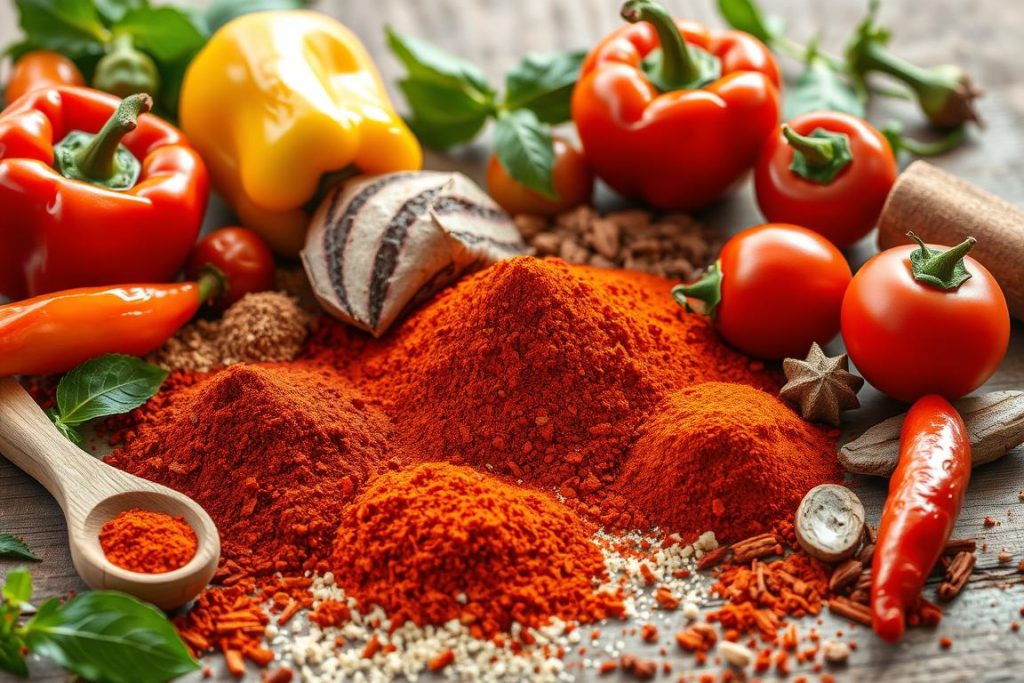
Proper Storage and Shelf Life
Keeping your paprika fresh is key to enjoying its flavor and color. Store it in airtight containers, away from heat, light, and moisture. A cool, dark place, like a pantry or spice drawer, is best.
Storage Best Practices
Storing paprika right helps keep it fresh. Here are some tips:
- Use airtight containers, like glass jars or heavy-duty plastic, to block air.
- Don’t store paprika near heat sources, like ovens or stovetops, as heat can harm its aroma and color.
- Keep it in a cool, dark spot, away from sunlight, to prevent color fading.
- Buy smaller amounts and replace them often for the best freshness.
Signs of Freshness
Paprika stays fresh for about 1 to 1.5 years when stored right. As it ages, it loses its strong smell and bright color. Look out for these signs:
- Fading color: Fresh paprika’s bright red will fade over time.
- Diminished aroma: The strong smell of paprika will lessen as it loses oils.
- Clumping or hardening: Moisture can make paprika clump or harden, changing its texture.
To keep your paprika’s color and smell, watch its storage. Use it within 1 to 1.5 years for the best taste.
Buying Guide: Choosing Quality Paprika
When you’re looking for paprika, make sure it only has one ingredient: single-ingredient product. Look for it in tin cans. These cans keep the spice fresh by blocking out light and air. The brighter the red, the better the quality.
For the best, buy paprika from reputable brands in Hungary or Spain. These places are known for their top-notch paprika. It’s made the old way, so it tastes just right.
- For smoked paprika, look for it from Spain’s La Vera region. It’s famous for its deep, rich taste.
- Choose sweet, hot, or smoked paprika based on your recipe. Sweet is good for mild dishes, while hot is for bold ones.
- Always pick the freshest paprika. Look for the latest production date and buy from stores that sell a lot.
“Investing in high-quality paprika can elevate your dishes and unlock a world of culinary possibilities.”
By following these tips, you’ll have the best single-ingredient product, tin packaging, color intensity, and reputable brands of paprika. It will make your cooking even better.
| Type | Flavor Profile | Heat Level | Best Uses |
|---|---|---|---|
| Sweet Paprika | Mild, slightly fruity | Low | Marinades, rubs, deviled eggs |
| Hot Paprika | Pungent, complex | High | Stews, chili, spice blends |
| Smoked Paprika | Deep, robust, smoky | Varies | Grilled meats, soups, sauces |
Common Substitutes and Alternatives
Smoked paprika has a special smoky taste. But, there are other options if you need them. For sweet paprika, try ancho chili powder. It’s mild and sweet.
For hot paprika, mix sweet paprika with cayenne pepper. This combo works well. Chipotle powder is a good choice for smoky flavor. It’s fruity and smoky.
Chili powder can sometimes replace paprika. But, it might change the taste because it has extra spices. For color without heat, use tomato powder or beetroot powder.
When picking substitutes, think about the taste and heat. This helps keep your dish’s flavor right.
| Paprika Variety | Substitute | Flavor Profile |
|---|---|---|
| Sweet Paprika | Ancho Chili Powder | Mild, sweet |
| Hot Paprika | Sweet Paprika + Cayenne Pepper | Spicy, with heat |
| Smoked Paprika | Chipotle Powder | Smoky, with a fruity undertone |
| Paprika (for color) | Tomato Powder, Beetroot Powder | No heat, added color |
Remember, when you swap out paprika, adjust the amount and balance the taste. This way, your dish will be just right.
Non-Culinary Uses and Applications
Paprika is more than just a spice. It’s a vibrant color and versatile tool for many uses. Artisans and those who love eco-friendly fashion use it to dye fabrics. They boil paprika in water and soak fabrics in it, creating beautiful red and orange shades.
In natural cosmetics, paprika adds color to lip balms and blushes. But, it must be used carefully to avoid skin problems. This shows how paprika can be used in many ways, helping us choose natural options over synthetic ones.
Natural Dyeing Properties
Paprika’s deep colors make it great for dyeing fabrics. People who make sustainable clothes use it to create warm, natural tones. They boil paprika in water and soak fabrics in it, letting the colors soak into the fibers.
Cosmetic Applications
Paprika is also used in some natural cosmetics. It’s good for lip balms and blushes because of its red color. But, it can irritate some skin. So, makers must test it carefully to make sure it’s safe and works well.
Paprika’s uses go beyond cooking. It’s a treasure for those who want sustainable, eco-friendly choices. Whether for dyeing or cosmetics, paprika’s colors and natural qualities are valuable. They help us move towards a greener future.
Conclusion
Smoked paprika is a special spice with a long history. It started in Central America and is now loved in Europe. This spice is key in the global spice trade.
There are many types of paprika, like sweet, hot, and smoked. Each one brings a special taste to food. It makes both old and new dishes better.
Smoked paprika is not just for cooking. It’s also important for its taste and health benefits. It makes food richer and more interesting.
It’s great in soups, stews, sausages, and sauces. This spice adds a smoky, earthy flavor. It can also make food healthier.
More people want real, high-quality spices. Smoked paprika from places like La Vera in Spain is very popular. Its unique making process keeps its special taste alive.
